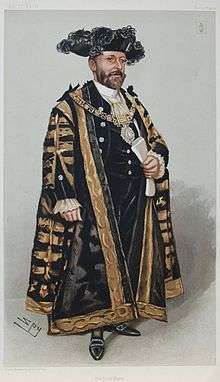Joseph Dimsdale

Sir Joseph Cockfield Dimsdale, 1st Baronet, PC, KCVO (19 January 1849 – 9 August 1912) was a distinguished public figure[1] in the late nineteenth and early twentieth centuries.
Early life
Dimsdale was born in Cornhill on 19 January 1849, the eldest son of Joseph Cockfield Dimsdale of Cleveland Square, London,[2] and educated at Eton. His father was from an old Quaker family with roots in Essex, and he was related to the physician and politician Thomas Dimsdale (1712-1800).[3]
Civic career
Dimsdale was the Managing Director of Prescott, Dimsdale and Co, bankers. He was Alderman of Cornhill from 1891 to 1902, was elected Sheriff of London for 1893, and Lord Mayor of London in September 1901 (serving November 1901 to November 1902).[4] He was a leading member of the Grocers' Company, of which he was for a time Master. In the 1900 general election, he was elected as the Member of Parliament (MP) for the City of London, and served one term until 1906.
He was knighted in 1894, in commemoration of the opening of the Tower Bridge and birth of an heir to the Throne while he was Sheriff. In 1902 he carried the Crystal Sceptre of the City of London in front of King Edward VII at his Coronation. The ceremony was re-scheduled from June to August, due to the King´s illness, but the 1902 Coronation Honours list was released on the intended coronation day on 26 June 1902, and announced that Dimsdale would receive a baronetcy.[5] He was created Baronet, of Goldsmiths, Langdon Hills, in the County of Essex and of Lancaster Street in the Borough of Paddington in the County of London, on 23 July 1902. Later that year he was appointed a Knight Commander of the Royal Victorian Order (KCVO) in the November 1902 Birthday Honours list.[6]
In June 1902 he received the 2nd class of the Japanese Order of the Rising Sun from Prince Komatsu Akihito, who was received formally at Mansion House as part of his visit to the United Kingdom to attend the coronation.[7]
A Past Grand Warden of the Freemasons of England, he was also an active member of the Primrose League.[3]
He died on 9 August 1912,[8] whilst in the office of Chamberlain of the City of London, a position he had held since 1902.
Family
Dimsdale married, in 1873, Beatrice Eliza Bower Holdsworth, daughter of Robert Hunt Holdsworth, of London, and had three children.[3] The eldest son, John Holdsworth Dimsdale (1874-1923), succeeded as 2nd Baronet.
References
- ↑ Warden of the Grocers Company
- ↑ “Who was Who” 1897–2007 London, A & C Black, 2007 ISBN 978-0-19-954087-7
- 1 2 3 "Civic ceremonies - Election of Lord Mayor". The Times (36573). London. 30 September 1901. p. 12.
- ↑ The Times, Saturday, 2 November 1901; pg. 9; Issue 36602; col A The Lord Mayor's Show
- ↑ "The Register, Adelaide, June 27, 1902. page 5". Trove. Retrieved 2013-08-21.
- ↑ The London Gazette: (Supplement) no. 27493. pp. 7161–7163. 7 November 1902.
- ↑ "Prince Komatsu at the Mansion Haouse". The Times (36802). London. 24 June 1902. p. 8.
- ↑ Obituary Sir Joseph Dimsdale The Times Monday, 12 August 1912; pg. 9; Issue 39975; col E
This page incorporates information from Leigh Rayment's Baronetage Page( ) which has further dates on it, not shown above.
External links
- Hansard 1803–2005: contributions in Parliament by Joseph Dimsdale
| Civic offices | ||
|---|---|---|
| Preceded by Frank Green |
573rd Lord Mayor of London 1901–1902 |
Succeeded by Sir Marcus Samuel |
| Parliament of the United Kingdom | ||
| Preceded by Sir Reginald Hanson, Bt Alban Gibbs |
Member of Parliament for the City of London 1900 – 1906 With: Alban Gibbs |
Succeeded by Sir Edward George Clarke Arthur Balfour |
| Baronetage of the United Kingdom | ||
| New creation | Baronet (of Goldsmiths and Lancaster Street) 1902–1912 |
Succeeded by John Holdsworth Dimsdale |